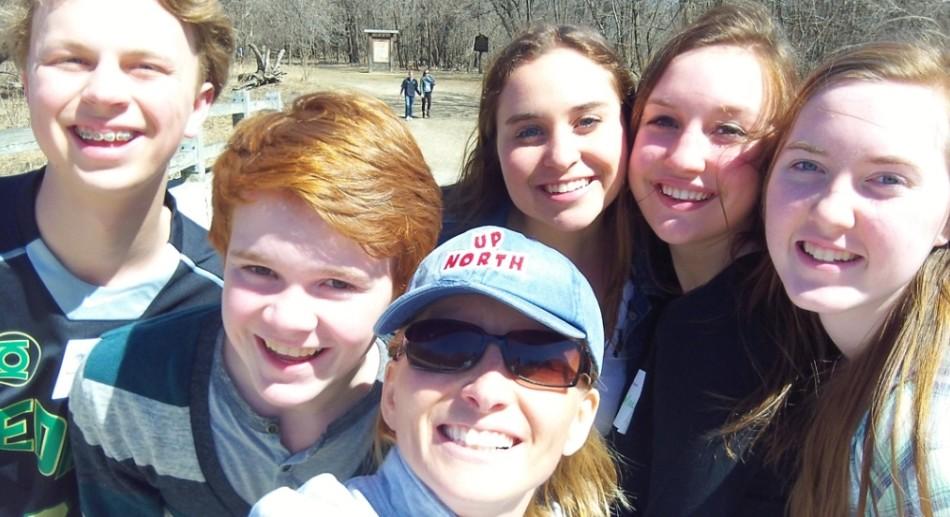From Bead Work to Bdote
Edina High School students visit Fort Snelling for an eye-opening educational experience.
April 16, 2014
From Bead Work to Bdote: Students Recall Fort Snelling Experience
On April 9th and 10th, forty-five sophomores and ten juniors and seniors had the opportunity to visit Fort Snelling State Park on a two day seminar to learn more about American Indian history, language, and culture in Minnesota. The students were taught by Glenn Wasicuna, one of the few remaining native Dakota speakers in the world, Dr. Gwen Westerman, current professor at Minnesota State University, Mankato who is also a poet and author of “Mni Sota Makoce: Land of the Dakota”, Julie Kastigar Boada, a nationally known Anishinaabe artist and puppeteer, and some of the state park’s rangers.
Students had the option to attend the seminar. “I wanted to learn the culture. Reading about it is one thing, but experiencing it is a completely different thing,” said sophomore Sophie Dupont.
Both days were structured with an introduction activity, three fifty minute teaching sessions, and a nature walk through historic parts of the park.
During the sessions, Wasicuna taught the alphabet of the Dakota language, proper pronunciations, and greetings. “It’s not just a language, it has a deeper meaning and you can tell how passionate they, [Westerman and Wasicuna], are about it,” said sophomore Josie Wilde.
Dr. Westerman taught a section on poetry and shared some of her published pieces. Students were asked to sit in five minutes of silence and experience what was going on around them. They then had the opportunity to create personal poems and present them to their small groups.
Kastigar Boada then taught the some of the history of the Anishinaabe in Minnesota and explained how she was never raised to be proud of her Anishinaabe culture and the impact that has had on her life. Because of her art background, Kastigar Boada also taught students bead work. Students were able to create leather journals with beaded covers. “I thought it was really nice to see the Dakota culture: their art, the poetry, the language itself, their background, and what their ideals are,” said sophomore Isabella Swanson.
Park rangers guided the nature walk, where students were able to see the land that the Dakota people call home. Also referred to as Bdote, the converging of the Mississippi and Minnesota Rivers is where the Dakota people began. The students were able to stand on the shore near this creation spot and marvel at its history and beauty.
“I’ve learned how the stages of development that our society has gone through have affected what is left of just nature… We are here in this national park, but it’s located under a bridge… there are birds, but there are also planes,” said sophomore Nathan Shapiro.
“I was hesitant at first. I originally came just because I wanted to see what it would be like. I wasn’t expecting it to be super fun or anything to be honest… it was really fun and I would definitely recommend it [to the incoming sophomores]” said Wilde.
The trip was free to students and funded by an art grant from the State. Students left with a knowledge that could not have been gained in a classroom.
From Bead Work to Bdote: Teachers Reflect on Cultural Seminar
Six Pre-AP English 10 teachers also joined in the experience.
According to Ms. Jackie Roehl, the teachers have already attended this cultural seminar. “I actually did this camp myself a couple years ago. Ms. Benson, Ms. Barniskis, and I came down here for a teacher camp with Glenn, Gwen, and Julie,” explained Roehl.
Like the students, the teachers also learned new things. For example, Roehl learned more about beavers, most notably the difference between weak pond beavers and strong river beavers. “I think it’s a way to bring all of these connections to life to see how language is tied to land is tied to the place is tied to history and nature,” explained Rachel Hatten.
Students were divided into small groups, each with two teachers actively participating in the activities. For example, Ms. Elizabeth Barniskis completed a beading project for her son, a baseball. Also, Roehl shared her poem about nature with her group, complete with Dakota words.
Even though teacher participation in the activities wasn’t required, it helped connect the students to their advisors. “I think that having a time just for students and adults of different ages to be together was invaluable… I was a student learning Dakota language along with my students and the seniors,” said Hatten.
“I think what stood out for me are things beyond English because that’s what I’m immersed in all day, and I really wish school could be like this… I think that education is just messed up, and if you want to have a lasting change [with students] we need more emotion and meaning,” said Roehl.
From Bead Work to Bdote: Poetry
Those who attended the Fort Snelling event had the opportunity to write poems inspired by nature. Check out some of the poems the students created!
From Bead Work to Bdote: Dakota Language
The Dakota language still has a lot of relevancy in today’s world. Check out the video above to learn about what students discovered about this unique language!
